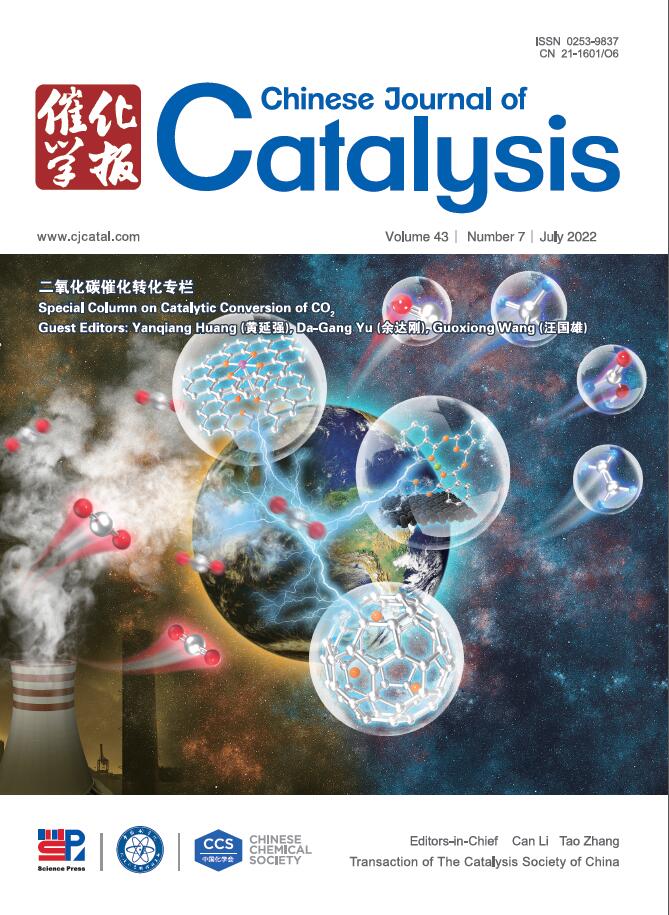Highly efficient hydrogenation of NO to NH3 via a Fe2O3/TiO2 catalyst
IF 15.7
1区 化学
Q1 CHEMISTRY, APPLIED
引用次数: 0
Abstract
Nitrogen oxides (NOx) present in flue gas are economically renewable N1 resources. Unlike traditional selective catalytic reduction processes that convert NO into N2, redirecting NO towards the synthesis of value-added NH3 offers significant practical benefits. In this study, a Ti-based metal-organic framework (Ti-MOF), specifically MIL-125, was utilized as a support for Fe, which was subsequently calcined at 400 °C to produce a Fe2O3/TiO2-MOF catalyst. The resulting catalyst demonstrated exceptional performance, achieving 99% NO conversion and 95% NH3 selectivity under optimal conditions of 450 °C, 0.1 MPa, and a gas hourly space velocity of 38000 mL g–1 h−1. Additionally, the catalyst exhibited excellent stability and resistance to water and sulfur. The high efficiency of Fe2O3/TiO2-MOF is attributed to the abundance of Fe2+ sites at the reaction temperature, which enhances NO adsorption and activation. Furthermore, density functional theory calculations suggest that NO undergoes hydrogenation at the N-terminus on the Fe2O3/TiO2-MOF surface, leading directly to NH3 synthesis rather than dissociation followed by hydrogenation. This catalyst presents a novel approach for converting NOx into high-value chemical products.
Fe2O3/TiO2催化剂催化NO加氢制NH3的研究
烟气中的氮氧化物(NOx)是经济上可再生的 N1 资源。与将 NO 转化为 N2 的传统选择性催化还原工艺不同,将 NO 转向合成高附加值的 NH3 具有显著的实际效益。在本研究中,利用钛基金属有机框架(Ti-MOF),特别是 MIL-125 作为铁的载体,然后在 400 °C 煅烧生成 Fe2O3/TiO2-MOF 催化剂。催化剂性能优异,在 450 °C、0.1 兆帕、气体时空速度为 38000 mL g-1 h-1 的最佳条件下,NO 转化率达到 99%,NH3 选择性达到 95%。此外,该催化剂还具有出色的稳定性和耐水性。Fe2O3/TiO2-MOF 的高效性归功于反应温度下丰富的 Fe2+ 位点,从而增强了对 NO 的吸附和活化。此外,密度泛函理论计算表明,NO 在 Fe2O3/TiO2-MOF 表面的 N 端发生氢化,直接导致 NH3 的合成,而不是先解离再氢化。这种催化剂提供了一种将氮氧化物转化为高价值化学产品的新方法。
本文章由计算机程序翻译,如有差异,请以英文原文为准。
求助全文
约1分钟内获得全文
求助全文
来源期刊

Chinese Journal of Catalysis
工程技术-工程:化工
CiteScore
25.80
自引率
10.30%
发文量
235
审稿时长
1.2 months
期刊介绍:
The journal covers a broad scope, encompassing new trends in catalysis for applications in energy production, environmental protection, and the preparation of materials, petroleum chemicals, and fine chemicals. It explores the scientific foundation for preparing and activating catalysts of commercial interest, emphasizing representative models.The focus includes spectroscopic methods for structural characterization, especially in situ techniques, as well as new theoretical methods with practical impact in catalysis and catalytic reactions.The journal delves into the relationship between homogeneous and heterogeneous catalysis and includes theoretical studies on the structure and reactivity of catalysts.Additionally, contributions on photocatalysis, biocatalysis, surface science, and catalysis-related chemical kinetics are welcomed.
 求助内容:
求助内容: 应助结果提醒方式:
应助结果提醒方式:


